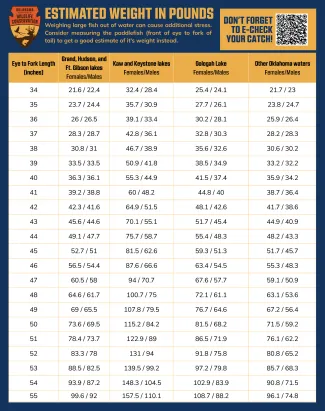
While the summer months are an important part of the growing season for Oklahoma’s world-class paddlefish, warm water temperatures can add additional stress when fish are caught and released. Historically, paddlefish snagging was only done in the spring when the fish moved upstream with the swelling rivers to spawn, making them vulnerable to snag anglers lining the riverbanks. With the increasing usage of boats and sonar equipment to locate and target paddlefish, springtime “snagging season” has expanded into late fall and early winter when the fish move into pre-spawn, upper-reservoir areas. And the adoption of high-resolution sonar technology has allowed for the targeting of large paddlefish in summer months, when they were traditionally difficult to locate.
With these exciting new fishing opportunities come a responsibility to safely handle the catch. We share tips for safe handling and low-impact snagging that should help enhance survival of paddlefish caught and released at any time of the year, but especially summer. These techniques and philosophies can be practiced with every snagged fish, even if they are harvested for the daily limit.
Be quick.
- Minimize the time to landing, hook removal, and release.
- Don’t cast a line until you’re equipped to land the fish.
- Think about where the fish will go if hooked and where you can intercept it. Is the path clear? Don’t expect to reel the fish upstream against the current.
- Think about ways to safely remove the hook without removing the fish from the water. Don’t forget about your own safety, too.
- If multiple anglers are fishing together and one hooks a fish, the others should retrieve their lines. Never try to double-hook a fish.
- Consider bringing the boat to the fish, when possible.
Release the Fish ASAP
- Any paddlefish taken into possession or restrained are considered “kept” and count to the angler’s daily limit.
- If you have no intention to keep a fish, please release it immediately.
- We understand you’ll likely want a pic with your awesome Oklahoma paddlefish. Please do this quickly and sparingly to help minimize the time out of water. Try not to take pics of every fish. Have the camera and photographer ready before the fish is landed. Try taking pics of the fish while it’s still in the water to minimize stress.
- We know you’re curious what your fish weighs. This length-weight table can help you guesstimate the size of fish you plan to release. Never weigh a paddlefish by hanging it from the jaws, mouth, or gills unless you plan to harvest the fish. Restraining a fish to weigh it would technically count as “taking into possession.”

Hug a Paddlefish.
- Never, ever lift a paddlefish by the jaw, mouth, or gills. If these parts get injured, it can mean a slow death for the fish.
- Paddlefish are heavy. Get someone to help you lift it if you need to. One person can grasp the rostrum, or “paddle,” and a second can grasp the tail. For really large fish, a third person can help in the middle. If you don’t have enough people to lift the fish safely, then you shouldn’t even remove it from the water.
- When posing for pictures, it will be easier on you and on the fish if you remember to Hug A Paddlefish. Grasp the fish under the belly and lift with your legs or pose for the pic while sitting.
Be aware of stress indicators and resuscitate when necessary.
If you are seeing these scenarios, it may be time to change your techniques or quit snagging for the day.
- Belly-up. The paddlefish is unable to right itself and continues to roll over on its back. This is a definite sign of stress and many fish cannot recover from this.
- The fish appears to be worn-out after a vigorous or extended landing time. The fish is upright, but remaining at the surface, slowly swimming, or not moving. After a brief recovery, the fish should be able to swim away upright on its own.
- Resuscitation may be required. Paddlefish need water flowing over their gills, so to enhance recovery, you may need to physically move the fish through the water. You can gently move the fish back and forth while upright or slowly move the boat forward – with the fish facing forward next to the boat – using a trolling motor or very slowly with the outboard.
- If you intended to release a fish, but it doesn’t seem to be recovering despite your best efforts, then you should consider taking responsibility and harvesting the fish, assuming you haven’t yet reached your annual harvest limit.
More About Paddlefish
- Paddlefish breathe through a technique called “ram ventilation” and are constantly in motion so they can get oxygenated water to their gills.
- Unlike many common sportfishes, paddlefish do not maintain territories, seek cover, or interact with their habitat.
- Paddlefish are mid-water or “pelagic” species, and the depth at which they are swimming is actively selected because it provides ideal food resources, temperature, or dissolved oxygen. In summer months, the reservoir depths at which a paddlefish can find its ideal conditions may be restricted by warm but oxygenated surface water and cooler, deep waters with little to no dissolved oxygen. As this layer of adequate temperature and oxygen narrows, also known as the “oxygen-temperature squeeze,” paddlefish stress increases and they are more susceptible to stress-induced mortality. Similar stressors can exist in a tailwater, although the circumstances are a bit different.
- Paddlefish are primitive fish and use a primitive air bladder for buoyancy. They don’t have the ability to actively regulate their buoyancy with small adjustments like other species. Paddlefish are negatively buoyant because their large rostrum or paddle provides lift while they are swimming. When paddlefish get stressed or confined, one of the symptoms is an expanded air bladder. This makes it difficult for them to orient themselves and to find the ideal depth where temperature and oxygen are appropriate.
Paddlefish anglers can be some of the best advocates for the species, for Oklahoma’s world-class paddlefish snagging opportunities, and for the safe handling and release of these amazing fish. If you have questions about how to hug a paddlefish, or have interesting paddlefish observations, let us know!
Jason Schooley, Senior Fisheries Biologist; (918) 504-0023; jason.schooley@odwc.ok.gov
Matthew Pallett, Paddlefish Biologist; (918) 299-2334; matthew.pallett@odwc.ok.gov